Ursa Minor constellation lies in the northern sky. The constellation’s name means “the smaller bear” or “the lesser bear” in Latin. The Great Bear constellation is represented by the larger Ursa Major.
Ursa Minor is one of the 48 Greek constellations. It was first catalogued by the Greek astronomer Ptolemy in the 2nd century CE. The constellation is easy to recognize in the night sky because it contains the famous Little Dipper asterism.
The Little Bear is also notable for marking the location of the north celestial pole. It is home to Polaris, the North Star. Polaris marks the end of the Little Dipper’s handle and the tip of the Little Bear’s tail.
The constellation Ursa Minor is believed to have been created by Thales of Miletus, a philosopher and astronomer who lived between 625 and 545 BCE and was known as one of the Seven Sages of Greece (early 6th century philosophers known for their wisdom).
It is also possible that Thales merely introduced the constellation to the Greeks. He was descended from a Phoenician family, and the Phoenicians frequently used Ursa Minor in navigation. Located in the region of the north celestial pole, the Little Bear constellation is an excellent guide to true north.
The Greeks sometimes called the constellation the Phoenician. Before it became known as the Little Bear (Μικρὰ Ἄρκτος), Ursa Minor was called the Dog’s Tail, or Cynosura (originally Κυνόσουρα in Greek).
Facts, location and map
Ursa Minor is the 56th constellation in size, occupying an area of 256 square degrees. It is located in the third quadrant of the northern hemisphere (NQ3) and can be seen from locations between the latitudes between +90° and -10°. The neighboring constellations are Camelopardalis, Cepheus and Draco.
The constellation name Ursa Minor is pronounced /ˌɜːrsə ˈmaɪnər/. In English, the constellation is known as the Little Bear. The genitive form of Ursa Minor, used in star names, is Ursae Minoris (pronunciation: /ˌɜːrsiː mɪˈnɒrɪs/). The three-letter abbreviation, adopted by the International Astronomical Union (IAU) in 1922, is UMi.
Ursa Minor belongs to the Ursa Major family of constellations, along with Coma Berenices, Boötes, Camelopardalis, Canes Venatici, Corona Borealis, Draco, Leo Minor, Lynx, and Ursa Major.
Ursa Minor contains four stars with confirmed planets and has no Messier objects. The brightest star in the constellation is Polaris, the North Star (Alpha Ursae Minoris), with an apparent magnitude of 1.97. The constellation contains 39 visible stars (brighter than magnitude 6.50).
There is one meteor shower associated with the constellation: the Ursids. The Ursid meteor shower peaks between December 18 and 25 every year. It is produced by the periodic comet 8P/Tuttle (Comet Tuttle).
Ursa Minor contains five named stars. The proper names of stars that have been officially approved by the International Astronomical Union (IAU) are Baekdu (8 Ursae Minoris), Kochab (Beta Ursae Minoris), Pherkad (Gamma Ursae Minoris), Polaris (Alpha Ursae Minoris), and Yildun (Delta Ursae Minoris).
The best time of the year to see Ursa Minor is during the month of June, when the constellation appears higher above the horizon around 9 pm.
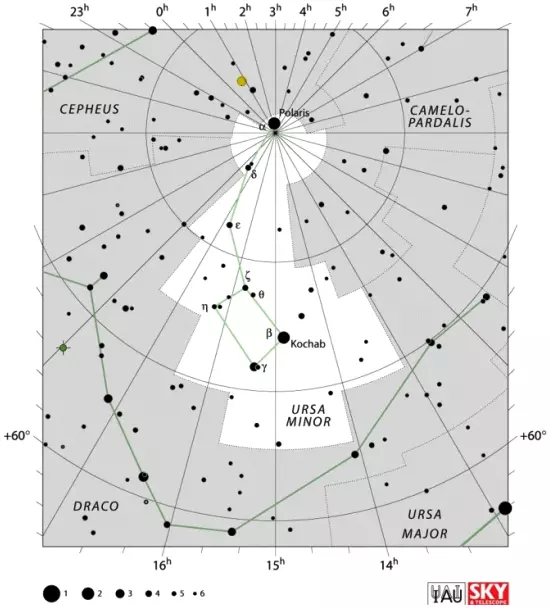
Ursa Minor constellation map by IAU and Sky&Telescope magazine (Roger Sinnott & Rick Fienberg) (CC BY 3.0)
Myth
Ursa Minor is associated with two different tales in Greek mythology. In one, the constellation represents Ida, the nymph who took care of Zeus on the island of Crete when he was small, along with Adrasteia, the nymph represented by the larger constellation Ursa Major.
In Greek lore, Zeus’ mother Rhea hid Zeus on the island when he was very young to protect him from his father Cronus. Fearful of an old prophecy that predicted that one of his children would overthrow him, Cronus swallowed five of his children immediately after they were born.
When Zeus was born, Rhea tricked Cronus into swallowing a stone instead, and Zeus eventually fulfilled the prophecy. He freed his brothers Poseidon and Hades and sisters Hera, Hestia and Demeter, and became the supreme god of the Olympians.
In a different myth, the Ursa Minor constellation represents Arcas, son of Zeus and the nymph Callisto. Callisto had sworn a vow of chastity to Artemis, but was later unable to resist Zeus’ advances and the two had a child, Arcas. When Zeus’ wife Hera found out about the betrayal and the child, she turned the nymph into a bear. Callisto spent the next 15 years wandering in the woods and avoiding hunters.
One day, Callisto came face to face with her son. Scared, Arcas drew a spear, ready to do away with the bear. Luckily, Zeus saw the scene and intervened before it was too late. He sent a whirlwind that scooped the mother and son up to the heavens, where Callisto became Ursa Major and Arcas, Ursa Minor. In a slightly different version of the myth, it is the goddess Artemis who turns Callisto into a bear for breaking her chastity vow.
Arcas is more frequently associated with the constellation Boötes, the Herdsman.
In an older myth, the seven stars that form the Little Dipper were said to represent the Hesperides, the seven daughters of Atlas who tended to Hera’s orchard (the Garden of the Hesperides), where a tree of golden, immortality-giving apples grew.
Asterisms
Ursa Minor does not have any conspicuous asterisms. It is home to the Little Dipper, a large star pattern located near the brighter Big Dipper, formed by some of the Little Bear’s brightest stars.
The Little Dipper is a challenging target from urban areas, but it can be made out from areas without too much light pollution on a clear, dark night.
The constellation also contains the Diamond Ring, a small asterism near Polaris, visible in binoculars and telescopes.
The Little Dipper
The Little Dipper is a relatively faint asterism formed by seven stars in Ursa Minor. Unlike the brighter and larger Big Dipper, it requires good conditions to be seen because the middle four stars that form it are not very bright.
The stars that form the Little Dipper are Polaris (Alpha Ursae Minoris), Yildun (Delta Ursae Minoris), Epsilon Ursae Minoris, Eta Ursae Minoris, Zeta Ursae Minoris, Pherkad (Gamma Ursae Minoris), and Kochab (Beta Ursae Minoris).
Polaris, Kochab and Pherkad are easily visible in less-than-ideal conditions, but the other four stars do not stand out in light-polluted skies.
The Little Dipper can be found using the stars of the Big Dipper. Polaris, which marks the end of the Little Dipper’s handle, lies near the imaginary line extended from Merak through Dubhe, the outer stars of the bowl of the Big Dipper.
Kochab and Pherkad, the outer stars of the Little Dipper’s bowl, are parallel to Mizar and Alioth in the Big Dipper’s handle. The two bear constellations appear in the same region of the sky, but they do not border each other. The fainter stars of the constellation Draco appear between them.
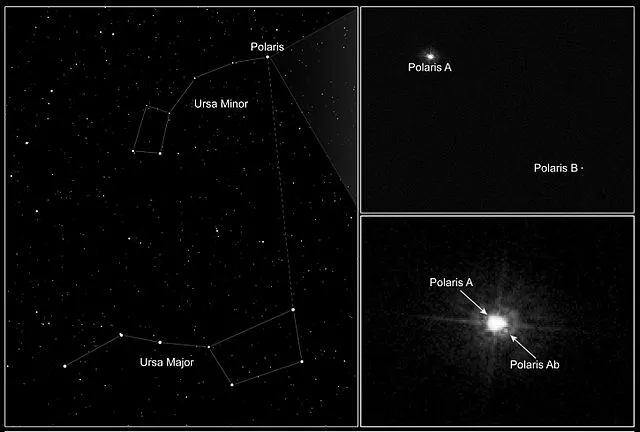
A close view to the Polaris trinary star system, credit: NASA, ESA, N. Evans (Harvard-Smithsonian CfA), and H. Bond (STScI)
Diamond Ring (Engagement Ring)
The Diamond Ring (or Engagement Ring) is a telescopic asterism that appears close to Polaris. It can be used to pinpoint the location of the north celestial pole. The asterism can be seen in binoculars and small telescopes.
The Diamond Ring is composed of 9th magnitude and brighter stars that form a circle almost a degree across near the border with the constellation Cepheus. The ring appears on one side of Polaris, while the north celestial pole appears on the other. The diameter of the ring is only a little larger than the separation between the North Star and the pole.
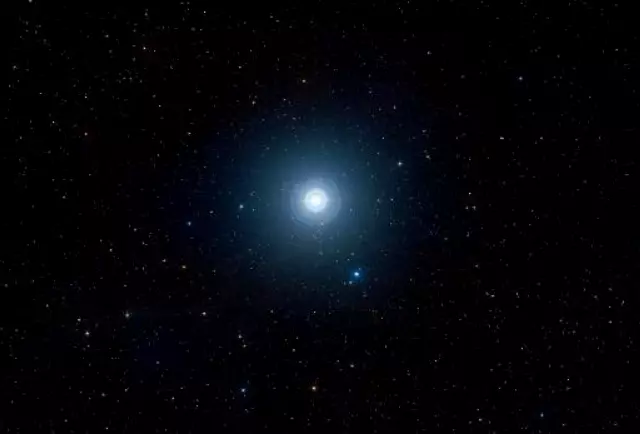
Polaris and the Engagement Ring, image: Wikisky
Ursa Minor stars
Ursa Minor does not host many bright stars. It is home to two second magnitude stars, Polaris (Alpha Ursae Minoris) and Kochab (Beta Ursae Minoris). Pherkad (Gamma Ursae Minoris) is the only other star in the constellation that is brighter than magnitude 4.0.
Kochab and Pherkad are known as the Guardians of the Pole because they appear to be rotating around Polaris. (All stars appear to rotate around the North Star, but Kochab and Pherkad are the nearest bright stars to the pole star.)
From 1500 BC to 500 AD, the two stars served as twin pole stars, being the closest bright stars to the north celestial pole. Neither of the two, however, was as close to the pole as Polaris currently is.
Polaris (the North Star) – α Ursae Minoris (Alpha Ursae Minoris)
Polaris (α UMi), the North Star, is the brightest star in Ursa Minor. Shining at magnitude 1.98, it is on average the 48th brightest star in the night sky. The supergiant star lies 323 – 433 light-years away.
Polaris marks the tip of the Little Bear’s tail and the end of the Little Dipper’s handle. It can be found by extending a line from Dubhe through Merak in the Big Dipper. Dubhe and Merak are the outer stars of the Big Dipper’s bowl. They are called the Pointer Stars because they point towards Polaris and the north celestial pole.
Polaris has been the closest bright star to the north celestial pole since the High Middle Ages. In 2018, it was 0.66 degrees from the pole. After the year 2100 it will come even closer, within 0.45 degrees (27 arcminutes).
Alpha Ursae Minoris is really a triple star system. Polaris (Alpha Ursae Minoris Aa), the primary component, is a yellow supergiant of the spectral type F7Ib. It has a mass 5.13 times that of the Sun and a radius between 37.5 and 46.27 times the Sun’s. With a surface temperature of 6,015 K, it is 1,260 times more luminous than the Sun.
The supergiant spins at 14 km/s, taking 119 days to complete a rotation. It has an estimated age of 45 – 67 million years.
Polaris is classified as a Population I classical Cepheid variable. The star’s variability was confirmed in 1911 by the Danish astronomer Ejnar Hertzsprung.
Classical Cepheids vary in brightness due to regular radial pulsations. Their pulsation period is closely related to their luminosity, which is why they make excellent standard candles for determining distances to deep sky objects. Polaris is one of the 800 known classical Cepheids in the Milky Way. Its brightness varies from magnitude 1.86 to 2.13 with a period of around four days.
Polaris has two smaller companions. The closer companion, Alpha UMi Ab, is a main sequence star of the spectral type F6 V with a mass of 1.316 solar masses and a radius of 1.04 solar radii. The star is three times more luminous than the Sun. It is believed to be more than 500 million years old. The two stars orbit each other with a period of 29.416 years at a separation of at least 2.90 astronomical units.
The more distant companion, Alpha UMi B, is a dwarf star of the spectral type F3 V, with an estimated age of 1.5 billion years. It has a mass of 1.39 solar masses and orbits at a distance of 2,400 AU. Polaris B can be seen in a small telescope. It was discovered by the German-born English astronomer William Herschel in 1780.
Two more distant stars were once believed to be part of the Alpha Ursae Minoris system. They were designated Alpha UMi C and Alpha UMi D. These stars are now known not to be physically related to Polaris.
Polaris is believed to be 2.5 times brighter today than it was in antiquity. In the last half century, it brightened 10 percent. In the 1800s, the supergiant star was 20 percent fainter. When Ptolemy observed it in the 2nd century CE, it was a third magnitude star. The 10th century Persian astronomer al-Sufi also reported Polaris to be a third magnitude star.
The dramatic change in brightness over such a short period is highly unusual. Astronomers have proposed that the supergiant may be closer to us now than it was 2,000 years ago.
Because of its brightness and proximity to the pole, Polaris is an important star in celestial navigation. It has been known by many different names across different cultures, including Stella Maris (Sea Star), Alruccabah, Phoenice, Lodestar (guiding star, derived from the Old Norse leiðarstjarna), Cynosūra (from the Greek κυνόσουρα, meaning “the dog’s tail”), Angel Stern, Star of Arcady, Yilduz, Mismar (“needle” or “nail”), Tramontana, Navigatoria and Pole Star.
The name Polaris comes from the Neo-Latin phrase stella polaris, meaning “polar star.”
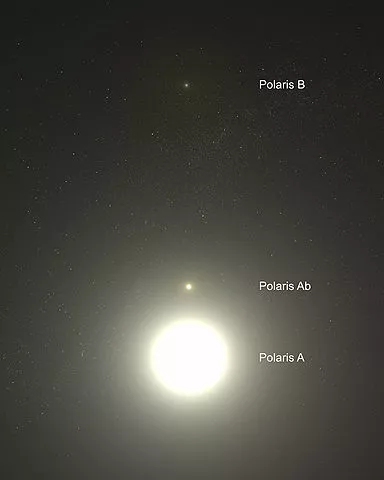
Polaris and its companion stars, image: NASA/ESA/HST, G. Bacon (STScI)
Kochab – β Ursae Minoris (Beta Ursae Minoris)
Kochab (β UMi) is a giant star of the spectral type K4 III. It has a visual magnitude of 2.08 and is 130.9 light years distant from the solar system. It is the brightest star in the bowl of the Little Dipper and the second brightest star in Ursa Minor.
Kochab has a mass of 1.3 solar masses and shines with 454 solar luminosities. It has a radius of 44.13 solar radii and an effective temperature of 4,008 K. The orange giant spins at around 1.7 km/s. It has an estimated age of 2.95 billion years.
The star’s traditional name comes from the Arabic al-kawkab, which means “the star.” The name is taken from the phrase al-kawkab al-šamāliyy, or “the north star.”
Pherkad – γ Ursae Minoris (Gamma Ursae Minoris)
Pherkad (γ UMi) is the third brightest star in Ursa Minor. It is a white giant star of the spectral type A2 III. It lies approximately 487 light-years away and has an apparent magnitude of 3.05.
The evolved star has a radius 15 times that of the Sun and shines with 1,100 solar luminosities. It is a very fast spinner, with a projected rotational velocity of 180 km/s.
Gamma Ursae Minoris is classified as a shell star, one that has a disk of gas surrounding its equator which causes variations in the star’s magnitude. Pherkad is also classified as a Delta Scuti variable (dwarf Cepheid), a young pulsating star whose brightness varies due to both radial and non-radial pulsations.
The star’s traditional name, Pherkad, is derived from the Arabic farqad, meaning “calf.” The name comes from the phrase aḫfa al farkadayn, which means “the dim one of the two calves.”
Pherkad has a visual companion, 11 Ursae Minoris. 11 UMi is sometimes known as Pherkad Minor. The two stars are not physically related. 11 UMi is an orange giant star located 410 light-years away. It shines at magnitude 5.15 and is visible to the unaided eye on a clear, dark night.
Yildun – δ Ursae Minoris (Delta Ursae Minoris)
Yildun (δ UMi) is a white main sequence dwarf of the spectral type A1Van. It lies approximately 172 light years from Earth and has a visual magnitude of 4.36. It is the nearest star to Polaris in the Little Dipper asterism.
Yildun has 2.35 times the Sun’s mass and a radius 2.8 times solar. With an effective temperature of around 9,911 K, it is 47.77 times more luminous than the Sun. Like Pherkad, it is a fast spinner. With an estimated rotational velocity of 154 km/s, it takes 19 hours to complete a rotation. The star is believed to be around 327 million years old.
The star’s traditional name, Yildun, comes from the Turkish word for “star,” yıldız. The name is sometimes also spelled Vildiur, Jildun, Yilduz and Gildun.
ζ Ursae Minoris (Zeta Ursae Minoris)
Zeta Ursae Minoris (ζ UMi) is a main sequence dwarf of the spectral type A3Vn. It has a mass of 3.4 solar masses and a radius 6.15 times that of the Sun. With a surface temperature of 8,720 K, the star is 227 times more luminous than the Sun. It shines at magnitude 4.29 from a distance of 369 light-years. It has an estimated age of 180 million years.
Zeta Ursae Minoris has a circumstellar disk and is thought to be on the verge of becoming a giant star. It is pulsating with a period of 15.8 hours and is classified as a suspected Delta Scuti variable.
Zeta Ursae Minoris is an exceptionally fast spinner. It rotates at 210 km/s. As a result, it has an equatorial bulge and is flattened at the poles. Its equatorial radius is about 10% larger than its polar radius.
Zeta UMi was historically called Akhfa al Farkadain. The name comes from the Arabic aḫfa al-farqadayn, which means “the dimmer of the two calves.”
η Ursae Minoris (Eta Ursae Minoris)
Eta Ursae Minoris (η UMi) is a yellow-white main sequence star of the spectral type F5 V. It is 97.6 light years distant from Earth and has a visual magnitude of 4.95.
The star is larger and more massive than the Sun, with a mass of 1.35 solar masses and a radius twice that of the Sun. It has an effective temperature of 6,858 K and shines with 7.7 solar luminosities. It spins at 84.8 km/s and has an estimated age of 1.061 billion years.
Eta Ursae Minoris has a visual companion at an angular separation of 228.5 arcseconds. The companion is much fainter and invisible to the unaided eye. It shines at magnitude 15.3. The two stars may form a wide binary system.
The traditional name of Eta UMi, Anwar al Farkadain, comes from the Arabic phrase ’anwar al-farqadayn, which means “the brighter of the two calves.”
ε Ursae Minoris (Epsilon Ursae Minoris)
Epsilon Ursae Minoris (ε UMi) is a binary star with a combined apparent magnitude of 4.19. It lies approximately 300 light-years away.
The star system is composed of Epsilon Ursae Minoris A, a yellow giant of the spectral type G5 III, and Epsilon Ursae Minoris B, a main sequence star with a class in the range A8-F0 V. The system has a magnitude 12.32 visual companion at a separation of 77 seconds of arc.
Epsilon Ursae Minoris A and B form a detached, single-lined spectroscopic binary star. The two components are very close together and cannot be resolved, even in a large telescope. They have an orbital period of 39.5 days.
Epsilon Ursae Minoris is classified as an eclipsing variable star and a RS Canum Venaticorum variable. The system’s brightness drops when the 11th magnitude component B passes in front of the component A and blocks some of its light. Large stellar spots contribute to the variation in observed brightness. The overall brightness of Epsilon UMi varies from magnitude 4.19 to 4.23.
5 Ursae Minoris
5 Ursae Minoris (5 UMi) is a red giant with the stellar classification K4 III. It shines at magnitude 4.253 and lies approximately 359 light-years away.
The star has a mass of 1.86 solar masses and a radius 16 times that of the Sun. It is 447 times more luminous than the Sun, with an effective temperature of 4,095 K. It has an estimated age of 2 billion years.
Baekdu (8 Ursae Minoris)
Baekdu (8 UMi) is a red clump giant of the spectral type G8III. It shines at magnitude 6.835 from a distance of 532 light-years. It has a mass 1.51 times that of the Sun and a radius 10.73 times the Sun’s. The star is believed to be 377 million years old. It has an unusually large abundance of lithium.
A planet, 8 Ursae Minoris b, was discovered orbiting the star in 2015 during an exoplanet survey of the north pole region with the 1.8 metre telescope at Bohyunsan Optical Astronomy Observatory (BOAO) in South Korea. The planet was reported to have a minimum mass of 1.5 Jupiter masses and an orbital period of 93 days with an eccentricity of 0.06.
8 Ursae Minoris b was the first planet discovered that has survived the period of evolutionary transition when an evolved star expands into a giant, engulfing any planets in close orbit.
8 Ursae Minoris b orbits its host star at a distance of around 0.5 astronomical units. This is very close considering that the parent star is a giant and that the planet should have been consumed when the star expanded to 0.7 astronomical units, before shrinking to its current size.
Astronomers have proposed that there may have been a stellar merger that changed the evolution of 8 UMi or produced 8 UMi b as a second-generation planet, formed from a gas cloud produced by the merger.
If there was a merger, the 8 UMi system originally consisted of two components and the merger may have prevented them from expanding to consume the planet.
In 2023, astronomers reported a 65-day radial velocity variation, possibly indicating a second planet orbiting at a distance of 5 or more astronomical units.
8 Ursae Minoris and 8 Ursae Minoris b were named Baekdu and Halla in the International Astronomical Union’s (IAU) 2019 NameExoWorlds competition. The star was named Baekdu after Peaktu Mountain, the tallest mountain in North Korea, and Halla after Hallasan, the tallest mountain in South Korea.
Calvera (1RXS J141256.0+792204)
Calvera is an X-ray source identified as a neutron star in 2007. It is one of the hottest and nearest neutron stars to the Sun. It lies within 500 parsecs.
Catalogued as PSR J1412+7922 and 1RXS J141256.0+792204, the stellar remnant was named after the villain in the film The Magnificent Seven (1960) as the eighth neutron star known within 500 parsecs (1,630 light-years) of Earth. More recent sources give a distance of over 2,000 parsecs (6,523 light-years).
In 2022, astronomers reported the discovery of a ring of low surface brightness radio emission around the Calvera pulsar. The ring is almost a degree across and offset 4.87 arcminutes from the pulsar. Astronomers believe that it is the remnant of the supernova event that produced the neutron star. If true, the supernova remnant is one of the few of its kind located in the Galactic halo.
H1504+65
H1504+65 is the second hottest white dwarf known, after RX J0439.8−6809. The peculiar star has a surface temperature of 200,000 K and is believed to be the stellar core of a post-AGB star. The star’s atmosphere is composed of carbon, oxygen and neon and its composition cannot be explained by the current models of stellar evolution.
H1504+65 has an apparent magnitude of 15.9 and lies approximately 1,590 light-years away.
Deep sky objects in Ursa Minor
Ursa Minor does not host any particularly bright deep sky objects that can be easily observed in binoculars and small telescopes. The constellation does not contain any objects listed in the Messier and Caldwell catalogues. However, it is home to a single object listed in the Herschel 400 catalogue, the spiral galaxy NGC 6217.
NGC 6217
NGC 6217 is a barred spiral galaxy that appears about 2.5 degrees east-northeast of Zeta Ursae Minoris. The galaxy has an apparent magnitude of 11.2 and lies approximately 67.2 million light-years away. It has an apparent size of 55,000 light-years. It can be observed in 4-inch and larger telescopes.
NGC 6217 is classified as a starburst galaxy with an active galactic nucleus. A supernova, SN 2018gj, was detected in the galaxy in 2018. It was a Type II supernova that peaked at magnitude 14.4.
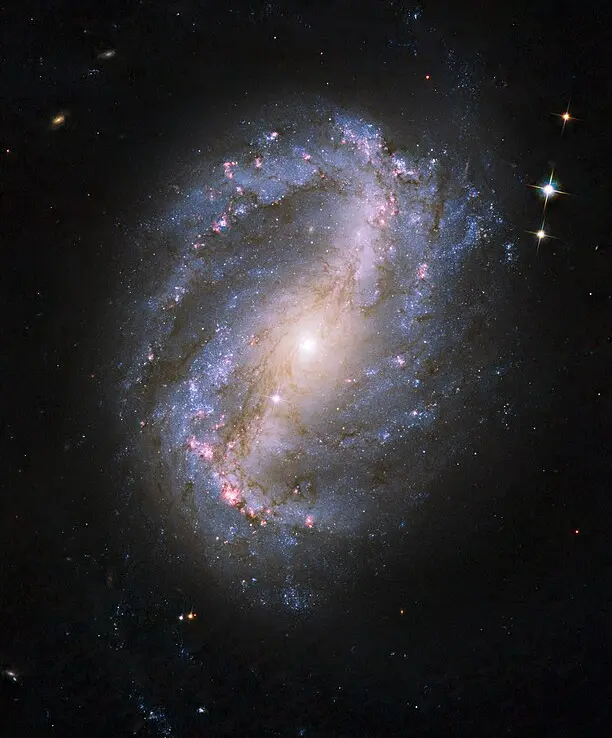
The barred spiral galaxy NGC 6217 was photographed on June 13 and July 8, 2009, as part of the initial testing and calibration of Hubble’s Advanced Camera for Surveys (ACS). The galaxy lies 67 million light-years away in the north circumpolar constellation Ursa Minor. Image credit: NASA, ESA, Hubble (PD)
Ursa Minor Dwarf (PGC 54074, UGC 9749)
The Ursa Minor Dwarf is a dwarf spheroidal galaxy in Ursa Minor. The Milky Way satellite has an apparent magnitude of 11.9 and is approximately 200,000 light years distant. The galaxy’s centre lies around 225,000 light-years from Earth.
Most stars in the Ursa Minor Dwarf are old and there is little to no star forming activity going on in the galaxy.
The Ursa Minor Dwarf galaxy was discovered by A.G. Wilson at the Lowell Observatory in 1955. Observations with the Hubble Space Telescope in 1999 confirmed that the galaxy had a two-billion-year long period of star formation about 14 billion years ago and straightforward evolution since.
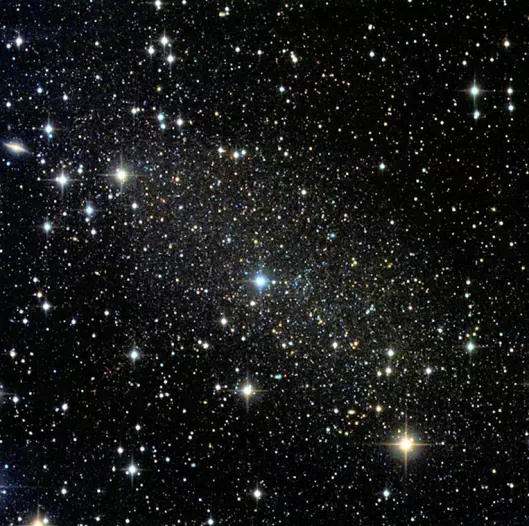
Ursa Minor Dwarf, image credit: Giuseppe Donatiello (CC0 1.0)
Polarissima Borealis – NGC 3172
NGC 3172 is a lenticular galaxy discovered by John Herschel in 1831. It lies approximately 285 million light-years away. It has a diameter of about 85 light-years and an apparent size of 0.92 by 0.79 arcminutes.
The galaxy was named Polarissima Borealis because it is the nearest NGC object to the north celestial pole. It appears less than a degree from Polaris.
Polarissima Borealis hosted two supernovae in recent decades. The type Ia supernova SN 2010af was detected in March 2010 and peaked at magnitude 17.2. Another type Ia supernova, SN 2017gla, was discovered in September 2017. It had a visual magnitude of 16.
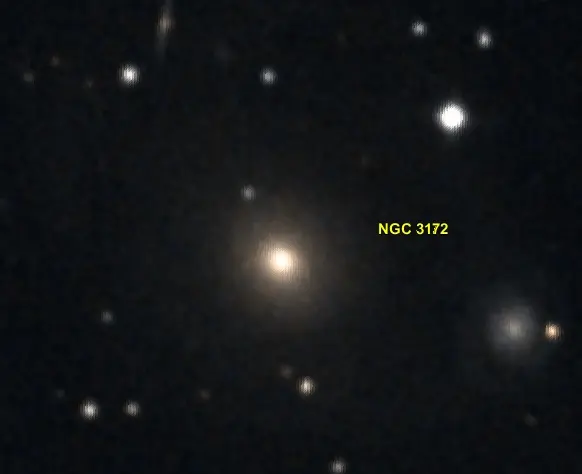
NGC 3172, image created using the Aladin Sky Atlas software from the Strasbourg Astronomical Data Center and Pan-STARRS (Panoramic Survey Telescope And Rapid Response System) public data, credit: Donald Pelletier (CC BY-SA 4.0)
NGC 6251
NGC 6251 is a supergiant elliptical galaxy located approximately 340 million light-years away. It has an apparent magnitude of 14.3 and an apparent size of 1.82 by 1.55 arcminutes.
NGC 6251 is classified as an active radio galaxy. It has an active galactic nucleus (Seyfert 2) with a supermassive black hole and also contains a one-sided radio jet. The jet was discovered in 1977 and is one of the brightest known.
The galaxy might be associated with a gamma ray source, designated 3EG J1621+8203, notable for its high-energy gamma-ray emission.
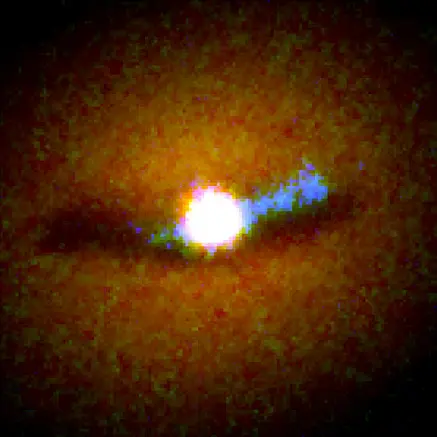
This composite image of the core of the galaxy was constructed by combining a visible light image taken with Hubble’s Wide Field Planetary Camera 2 (WFPC2), with a separate image taken in ultraviolet light with the Faint Object Camera (FOC). While the visible light image shows a dark dust disk, the ultraviolet image (color-coded blue) shows a bright feature along one side of the disk. Because Hubble sees ultraviolet light reflected from only one side of the disk, astronomers conclude the disk must be warped like the brim of a hat. The bright white spot at the image’s centre is light from the vicinity of the black hole which is illuminating the disk. Image credit: Philippe Crane (European Southern Observatory), and NASA/ESA (PD)
NGC 6331
NGC 6331 is an elliptical galaxy located 737 million light-years away. It has an apparent magnitude of 14.4. The galaxy has a physical diameter of about 345,000 light-years. It is the brightest member of the galaxy cluster Abell 2256. NGC 6331 forms a triplet with two fainter galaxies in the cluster.
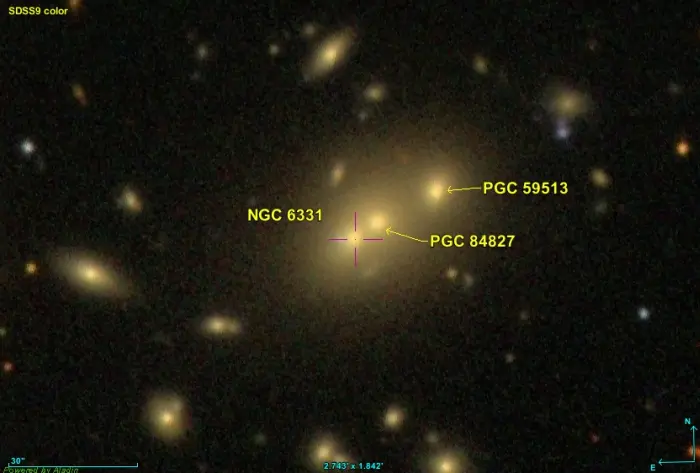
NGC 6331, image created using the Aladin Sky Atlas software from the Strasbourg Astronomical Data Center and SDSS (Sloan Digital Sky Survey) public data, credit: Donald Pelletier (CC BY-SA 4.0)
NGC 5034
NGC 5034 is a spiral galaxy located 401.5 million light-years away. It has an apparent magnitude of 14.6. The galaxy was discovered by William Herschel on April 7, 1793.
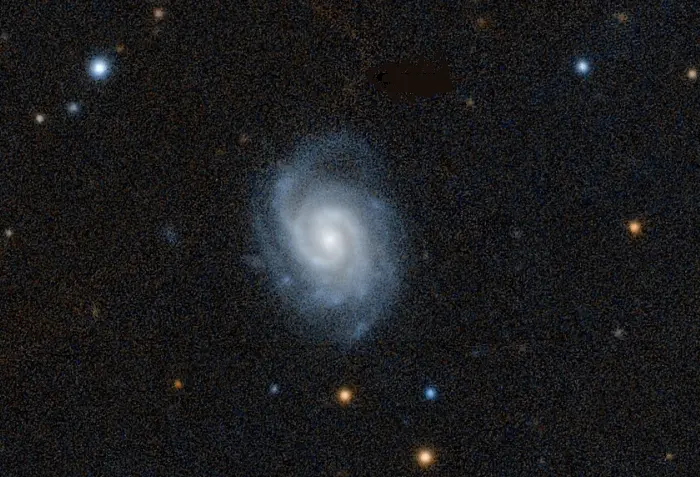
NGC 5034, image created using the Aladin Sky Atlas software from the Strasbourg Astronomical Data Center and
Pan-STARRS (Panoramic Survey Telescope And Rapid Response System) public data, credit: Donald Pelletier (CC BY-SA 4.0)